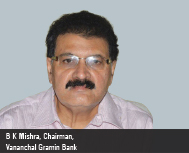
CIOTechOutlook >> Magazine >> July - 2014 issue
Technology Yet to Touch Rural Banking
By
 Vananchal Gramin Bank was established in 2006 with the amalgamation of erstwhile Santhal Parganas Gramin Bank and erstwhile Palamau Kshetriya Gramin Bank. The bank is sponsored by SBI and owned by Govt. of India. Govt. of Jharkhand and SBI.
Vananchal Gramin Bank was established in 2006 with the amalgamation of erstwhile Santhal Parganas Gramin Bank and erstwhile Palamau Kshetriya Gramin Bank. The bank is sponsored by SBI and owned by Govt. of India. Govt. of Jharkhand and SBI.Even after nationalization of major commercial banks, a large proportion of the rural people & area were outside the banking fold. Hence, Regional Rural Banks were established under the Regional Rural Bank Act. 1976 as an alternative rural credit agency having local feel and familiarities of rural problems. Regional Rural Bank aims to act as a catalyst and lubricate the process for accelerating the agricultural growth and rural development, generating self employed opportunities, poverty alleviation and minimize regional and sectoral imbalances. The RRBs have played a key role in rural institutional financing to the development of the rural economy.
Based upon the direction of the report of the working committee of Technology up-gradation of RRB, the RRBs recognize that core banking is vital not only for leveraging internal operations but also for retaining their position amongst the higher echelons of the Banking system. Now, RRBs have migrated to Core Banking Platform with facilities of remittance through NEFT, RTGS, SMS Alert, ATM Cards and RuPay Kisan Cards and others. BC network is going to take place under geographical cluster approach. RRBs have also set up Ultra Small Branch. Rural Banks also adopted technology and new business process to maintain their importance in banking and to serve rural people of the country. RRBs are playing major role in reaching out to women in rural areas. RRBs are important model for furthering banking activity in rural areas. Technology plays an important role in reducing operating cost of providing banking services particularly in the rural areas and to low income group. Recent developments in banking technology have provided the perfect pad for extending outpost to remote location without having to open bank branches in the area.
There are three broad types of technology that have been identified to drive the growth of financial services. These are (i) Pro-poor low cost cell phone (ii) ATMs and other points of sales devices (iii) Smart Plastic Card. Biometric method for uniquely identifying customers is also being increasingly adopted.
As envisaged by the Govt. of India, RRBs as a group have become strong intermediary for financial inclusion in rural areas. RRBs have also opted for branchless banking model based on Business Correspondent (BC) and use of small hand hold devices. This technology enables bank to reach out the villagers by offering them savings and loan products at their door steps thereby saving time of customer and also their cost of travel to the branch. The rural bank is able to reach out to the hitherto un-reached segments and mop up rural savings at lower transaction cost. The appropriate technology combined with an effective use of Business Correspondents has the potential of providing basic banking service in every village.
For Financial Literacy RRBs with the help of NABARD have been establishing Financial Literacy Centres. The objective of the FLC is to spread financial literacy/education and credit counseling. (i) To make the rural households fully aware of the advantages of being connected with the formal financial sector and educate them thoroughly in respect of full details of various financial products and services being provided by banks including the procedure to avail them. (ii) To provide face to face financial counseling services so as to clarify all their doubts/misgivings.
Since technology application is widely encouraged in rural, semi urban and un-banked areas to provide financial services to one and all through financial inclusion programme, these centres have great role and responsibility to make customer fully aware of all kinds of technology so as to enable them to use the services properly and effectively. As such full time and adequately qualified/trained counselors have been engaged and functioning of the centres are being effectively monitored.
Vananchal Gramin Bank is operating in nine most backward districts of Jharkhand state. VGB has 203 branches, out of them 180 branches are situated in remote rural areas. VGB is committed to serve progressively all households in every village of their service area and has taken steps for Financial Literacy among the rural people of their area and adopt advance technology application. In addition, we furnish some special features of Vananchal Gramin Bank as under:-
(i) All branches of VGB migrated to Core Banking Solution in June 2011. CBS lab has been established for imparting training to the staff of the bank.
(ii) ATM card & RuPay Kisan Card for KCC Account holders have been started, which can be used at all ATM and POS Machines.
(iii) Internal Journal "Vananchal Jagran" is published quarterly.
(iv) Bank has made arrangement to provide insurance products and mutual fund products to their customer through their branches.
(v) VGB has adopted Sunderpahari Block of Godda District to credit link all eligible household of 208 villages of the Block.
(vi) VGB is the largest Channel partner of NSTFDC in the state & 2nd largest partner in the country. NSTFDC provide refinance to VGB.
(vii) VGB has entered into an MOU with NSFDC to provide loan to SC at concessional rate.
(viii) Reward and recognition ceremony is organized to felicitate the staff on achievement of targets in key areas.
(ix) Blood Donation Camps are organized at district head quarters at frequent intervals.
(x) We have established 9 FLCs, one in each District Head Quarter of our area of operation.
(xi) Head Office of VGB is the only Wi-Fi enabled bank's office in the state of Jharkhand & Bihar.
CXO Insights
Social Media Analytics in the Banking Industry:...
By S. Ganesh, CEO & MD, Dun & Bradstreet Technologies and Data Services
Improving Customer Experience with a Dedicated...
By Nitin Singhal, Senior Director, CX Solutions, Oracle India
Real Estate Sales - A Blend of Technology and...



